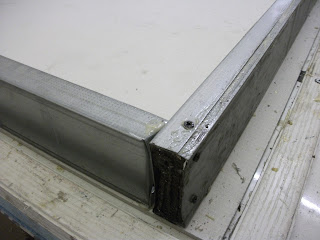6mm Mgo board screwed & glued ( to seal edge ) to supporting frame
Close up (25mm -32mm drywall screws used )
Close up of frame edge ( 2m long DES - Door edge strip )
Door frame off cut corner braces screwed in
Mid bean inserted
Foil sided Kingspan (80mm ) inserted . It will have expanding foam gluing it togethere & sealing edges to reduce thermal bridge
The second prototype was tried , using drywall steel frame & cardboard in fill. The edges were sealed with silicone sealant & expanding foam . This seals the air inside the cardboard inner.
WARNING: Although the outer frame & Mgo board is highly fire resistant, the cardboard inner is flammable, so should one be used in low fire risk out buildings.
Alternatively the frame can be made of dry wall, which for reduction of bulk in transport, can be stored inside a larger size length
Prototype 2 ( steel drywall frame, cardboard box insulation, silicone sealant & expanding foam )
Frame is lined with folded cardboard
End sealed with silicone sealant
Frame sccrewed & glued
Close up
Corner braces screwed in

Folded cardboard boxes (triple wall ideally ) inserted
The mid beam was made by screwing off cuts of drywall together , having slid one into another
Expanding foam screwed in to seal edges of cardboard to increase insulation value & seal air gaps
A sheet of plastic was placed on drying foam & a 12mm ply board screwed down to keep foam expanding into air gaps & not escaping. Plactic sheet used to stop foam sticking to board.
If the pressure of the foam expansion bends the board, a machine press, like our prototype here may need to be used like here
https://cabinznet.blogspot.co.uk/2016/11/machine-press-prototype-built-from.html


























